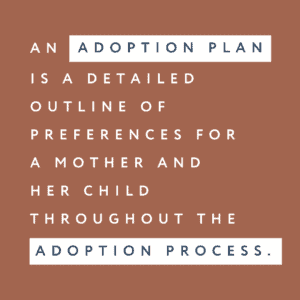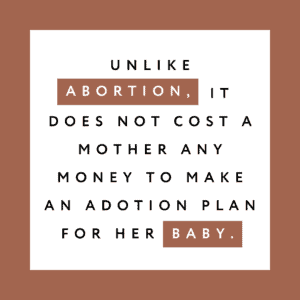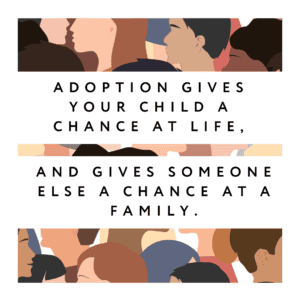If you’re facing an unplanned pregnancy and are feeling unsure about your ability to provide for a child-you are not alone. It is estimated that 45% of pregnancies are unplanned. Women face the dilemma of adoption vs. abortion every day.
Both courses of action involve vital decisions. It’s important to research and seek education before making a permanent choice. The various opinions, facts, and terminology can be extremely daunting. So let’s break it down.
It is important to know adoption is always on the table. During pregnancy, in the hospital, or after birth, adoption will be an available option.
Domestic Infant Adoption is when a birth mother voluntarily selects a family to become the permanent, adoptive parents of her child. Infant adoption is done either through an agency or independently.
The primary difference between independent and agency adoptions is the amount of professional involvement.
When the birth mother wants an adoptive family, an adoption agency may be the best option. Adoption agencies provide professional services. For example, they help with family selection, adoption attorneys, counseling, and guidance in with an adoption plan.
If the birth mother already knows and approves of a family, she could proceed without an adoption agency. The family will still be required to find a home study provider and adoption attorney.

When working with an adoption agency, mothers have the opportunity to meet with and select a family. The adoption agency will also work with both parties to form an adoption plan. An adoption plan is a detailed outline of preferences for her and her child throughout the process.
There are three types of adoptions; open, semi-open, and closed. The type of adoption outlined in the plan determines the relationship between the family, child and birth mother.
An important factor to consider when deciding the adoption type is the needs and health of the child.
Open adoption is the most common type of infant adoption. Prior to the 1990s, open adoption was very rare. However, in the last thirty years, open adoptions have risen to around seventy percent. Open adoptions allow for identifying information to be shared between the family and the birth mother. For example, regular contact can happen through emails, phone calls or in-person visits. Open adoption is typically a healthier option for the child because their birth mother can answer their questions as they grow up.
In a semi-open adoption, non-identifying information is shared. Or course, sharing of information goes through the agency.
If an adoption is closed, there is no information shared and no contact between the family and the birth mother.
In comparison to abortion, adoption does not cost the mother any money.
For example, in most states, adoptive parents provide financial help to birth mothers for pregnancy-related expenses. Adoption agencies can only give as much as the state allows. However, based on the situation, some expenses such as medical bills, groceries and living expenses can be covered.

When considering adoption, fear and confusion are natural feelings. It’s vital for a mother to give herself time to process what is best for her and her child. Nothing is determined until the paperwork is signed. Some even decide to wait until after birth before signing papers.
Safe Haven Baby Boxes allows women to safely surrender their child, while remaining anonymous. Their 24-hour hotline is a resource for mothers in crisis. Safe Haven Baby Boxes have locations all over the United States.
Abiding Love Charities offers resources for birth parents, adoptive parents, and adoptees. Support groups, post-placement advocates, and mediation services are a few of the resources that are available for birth mothers.
Ultimately, adoption gives your child a chance at life and gives someone else a chance at a family. There are many couples who struggle with infertility and long for a baby. A child could be the beginning of a wonderful chapter in somebody’s life.
Additional Resources:

Like adoption, the decision to abort a baby is permanent. Regarding abortion, it’s important to research and process to make an educated decision. An ultrasound can be the first step.
There are three types of abortions performed in the United States. The abortion pill, vacuum aspiration, and dilation & evacuation (D&E).
The abortion pill is the only abortion that can be performed at home. It is used when the baby is less than ten weeks. The abortion pill will cause the mother to miscarry the baby, resulting in cramping and bleeding.
Vacuum Aspiration is the common method of abortion during the first trimester. A hollow tube that is attached to a pump is inserted into the cervix, creating a vacuum that removes the baby from the uterus by suction.
In Dilation and Evacuation (D&E) abortions, the baby’s heart is given a lethal injection, and medical tools are used to extract the fetus through the birth canal.
Additional Resources:
The cost of an abortion varies depending on your state and health center. The typical range is from five hundred to over one thousand dollars.
Both abortion and adoption will have a significant impact on a mother’s life, as well as her child’s life. When deciding the next step in an unexpected pregnancy, consider what is in the best interest of the child.
Choosing to get an abortion can have serious emotional repercussions such as depression, anxiety, grief and regret. Choosing adoption has an emotional impact but gives your child the chance at a fulfilling life. In addition, it gives you the possibility of watching your child flourish and grow.
The post Adoption vs. Abortion: What are My Options? appeared first on Focus on the Family.
Continue reading...
Both courses of action involve vital decisions. It’s important to research and seek education before making a permanent choice. The various opinions, facts, and terminology can be extremely daunting. So let’s break it down.
Adoption
It is important to know adoption is always on the table. During pregnancy, in the hospital, or after birth, adoption will be an available option.
Domestic Infant Adoption is when a birth mother voluntarily selects a family to become the permanent, adoptive parents of her child. Infant adoption is done either through an agency or independently.
Agency vs. Independent: What's the Difference?
The primary difference between independent and agency adoptions is the amount of professional involvement.
When the birth mother wants an adoptive family, an adoption agency may be the best option. Adoption agencies provide professional services. For example, they help with family selection, adoption attorneys, counseling, and guidance in with an adoption plan.
If the birth mother already knows and approves of a family, she could proceed without an adoption agency. The family will still be required to find a home study provider and adoption attorney.
The Family: Do I Get to Meet Them?

When working with an adoption agency, mothers have the opportunity to meet with and select a family. The adoption agency will also work with both parties to form an adoption plan. An adoption plan is a detailed outline of preferences for her and her child throughout the process.
There are three types of adoptions; open, semi-open, and closed. The type of adoption outlined in the plan determines the relationship between the family, child and birth mother.
Adoption vs. Abortion: What is Open, Semi-open, and Closed?
An important factor to consider when deciding the adoption type is the needs and health of the child.
Open Adoption
Open adoption is the most common type of infant adoption. Prior to the 1990s, open adoption was very rare. However, in the last thirty years, open adoptions have risen to around seventy percent. Open adoptions allow for identifying information to be shared between the family and the birth mother. For example, regular contact can happen through emails, phone calls or in-person visits. Open adoption is typically a healthier option for the child because their birth mother can answer their questions as they grow up.
Semi-Open Adoption
In a semi-open adoption, non-identifying information is shared. Or course, sharing of information goes through the agency.
Closed Adoption
If an adoption is closed, there is no information shared and no contact between the family and the birth mother.
Is Adoption an Affordable Option?
In comparison to abortion, adoption does not cost the mother any money.
For example, in most states, adoptive parents provide financial help to birth mothers for pregnancy-related expenses. Adoption agencies can only give as much as the state allows. However, based on the situation, some expenses such as medical bills, groceries and living expenses can be covered.

What if I Change My Mind?
When considering adoption, fear and confusion are natural feelings. It’s vital for a mother to give herself time to process what is best for her and her child. Nothing is determined until the paperwork is signed. Some even decide to wait until after birth before signing papers.
Resources Are Available
Safe Haven Baby Boxes allows women to safely surrender their child, while remaining anonymous. Their 24-hour hotline is a resource for mothers in crisis. Safe Haven Baby Boxes have locations all over the United States.
Abiding Love Charities offers resources for birth parents, adoptive parents, and adoptees. Support groups, post-placement advocates, and mediation services are a few of the resources that are available for birth mothers.
Ultimately, adoption gives your child a chance at life and gives someone else a chance at a family. There are many couples who struggle with infertility and long for a baby. A child could be the beginning of a wonderful chapter in somebody’s life.
Additional Resources:
- Open vs. Closed Adoption, A Birth Mom’s Advice
- What is Open Adoption?
- Alternatives to Abortion: Pregnancy Resource Centers

Abortion
Like adoption, the decision to abort a baby is permanent. Regarding abortion, it’s important to research and process to make an educated decision. An ultrasound can be the first step.
There are three types of abortions performed in the United States. The abortion pill, vacuum aspiration, and dilation & evacuation (D&E).
Types of Abortions: What is the Difference?
The abortion pill is the only abortion that can be performed at home. It is used when the baby is less than ten weeks. The abortion pill will cause the mother to miscarry the baby, resulting in cramping and bleeding.
Vacuum Aspiration is the common method of abortion during the first trimester. A hollow tube that is attached to a pump is inserted into the cervix, creating a vacuum that removes the baby from the uterus by suction.
In Dilation and Evacuation (D&E) abortions, the baby’s heart is given a lethal injection, and medical tools are used to extract the fetus through the birth canal.
Additional Resources:
- Abortion Facts, Stats and Research
- The History of Abortion
- Abortion Complications
- The True Cost of Abortion
Counting the Cost
The cost of an abortion varies depending on your state and health center. The typical range is from five hundred to over one thousand dollars.
Both abortion and adoption will have a significant impact on a mother’s life, as well as her child’s life. When deciding the next step in an unexpected pregnancy, consider what is in the best interest of the child.
Choosing to get an abortion can have serious emotional repercussions such as depression, anxiety, grief and regret. Choosing adoption has an emotional impact but gives your child the chance at a fulfilling life. In addition, it gives you the possibility of watching your child flourish and grow.
The post Adoption vs. Abortion: What are My Options? appeared first on Focus on the Family.
Continue reading...





